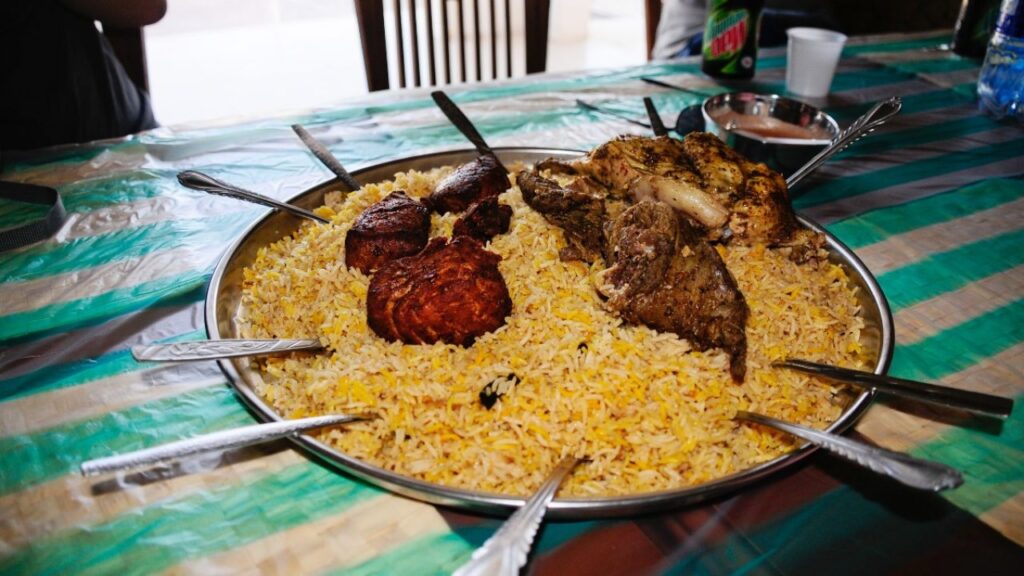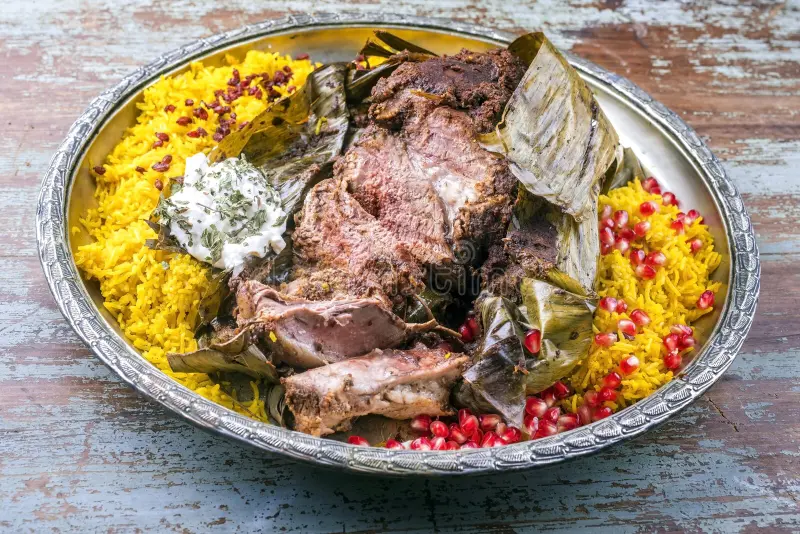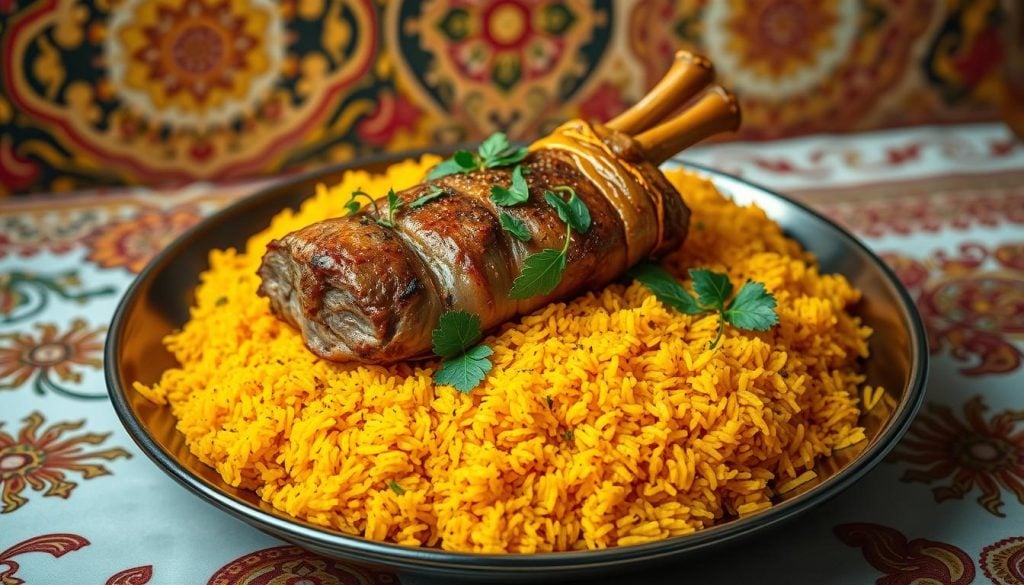Omani cuisine is a tapestry of flavors, steeped in centuries of tradition and enriched by the region’s diverse history. Among its culinary treasures, lamb dishes hold a special place. From festive gatherings to everyday meals, Omani lamb is celebrated for its tender texture, aromatic spices, and the love infused into each preparation. Exploring Omani lamb dishes is like taking a journey through the heart of Oman, where each dish tells a story of culture, community, and culinary mastery.
Majboos: The Quintessential Omani Lamb Rice
Majboos is perhaps the most iconic lamb dish in Oman. This fragrant rice dish, cooked with tender lamb and infused with a blend of spices, embodies the warmth of Omani hospitality. Saffron, cardamom, cloves, and black lime are often used, giving Majboos its distinctive aroma and rich flavor profile.
The preparation of Majboos is both an art and a labor of love. The lamb is slowly simmered until it is tender and infused with the spices, while the rice absorbs the flavorful broth, creating a harmonious blend of taste and texture. Majboos is often garnished with fried onions, raisins, and nuts, adding a subtle sweetness and crunch that balances the savory lamb.
In Oman, Majboos is more than just a meal; it is a symbol of celebration. Served during weddings, family gatherings, and special occasions, it brings people together, fostering a sense of unity and shared enjoyment. Each family may have its own version, passed down through generations, reflecting the unique heritage of different regions within Oman.
Shuwa: The Slow-Cooked Celebration
Shuwa is a culinary masterpiece, often reserved for the most festive occasions. This slow-cooked lamb dish requires patience and care, as the meat is marinated with a complex mixture of spices, wrapped in banana or palm leaves, and buried in an underground clay oven called a “tandoor” or “sand oven.” The result is lamb so tender that it falls apart effortlessly, infused with smoky flavors and aromatic spices.
The making of Shuwa is an event in itself. Families and communities come together, often days in advance, to prepare the lamb. The process reflects a deep cultural tradition, emphasizing not just the food, but the connection between people and their heritage. When the Shuwa is finally unearthed, the aroma fills the air, signaling a moment of joy and communal celebration.
Shuwa is often served with fragrant rice, traditional bread, or a simple salad, allowing the lamb’s rich flavor to shine. Each bite is a testament to the patience, skill, and love involved in its preparation, making it a dish that is as memorable as it is delicious.

Mashuai: The Sweet and Savory Harmony
Mashuai is another celebrated Omani lamb dish, known for its unique combination of flavors. The dish features succulent lamb, often roasted or grilled, served alongside tangy, sweet accompaniments like tamarind or date sauce. This balance of sweet and savory is characteristic of Omani cuisine, where spices and flavors are carefully layered to create a harmonious taste experience.
Preparing Mashuai involves marinating the lamb with a mixture of local spices and sometimes citrus juices to enhance its natural flavors. The cooking process allows the lamb to retain its juiciness while developing a slightly caramelized exterior. Served with rice or flatbread, Mashuai is a versatile dish that can be enjoyed in both casual and formal settings, reflecting the adaptability and creativity of Omani culinary traditions.
Rosh: The Flavorful Stew
Rosh is a hearty Omani lamb stew, perfect for family meals and gatherings during cooler months. The dish combines tender lamb with a medley of vegetables, legumes, and aromatic spices, simmered to perfection in a rich broth. The slow cooking process allows the flavors to meld, resulting in a comforting dish that is both satisfying and nourishing.
One of the hallmarks of Rosh is its ability to bring together simple ingredients to create something extraordinary. Tomatoes, onions, garlic, and local spices like cumin and coriander are often combined to form a base, while the lamb adds depth and richness. Served with traditional Omani rice or bread, Rosh exemplifies the concept of home-cooked comfort food elevated by skillful seasoning and preparation.
Mashkool: A Modern Twist on Tradition
Mashkool represents the evolving face of Omani cuisine, where traditional lamb dishes are given a contemporary touch. Chefs in Oman are experimenting with new techniques, ingredients, and presentation styles, creating dishes that honor tradition while appealing to modern palates.
In Mashkool, lamb might be paired with exotic grains, infused oils, or unique spice blends, resulting in a dish that is both innovative and deeply rooted in Omani heritage. This blending of old and new showcases the dynamism of Omani culinary culture, where respect for tradition meets the excitement of experimentation.
Aromatic Spices: The Soul of Omani Lamb
A discussion of Omani lamb dishes would be incomplete without highlighting the role of spices. Omani cuisine is renowned for its fragrant and complex spice blends, which enhance the natural flavors of lamb and elevate each dish to a sensory experience.
Cardamom, saffron, black lime, cloves, cinnamon, cumin, and coriander are commonly used, each contributing a distinct aroma and flavor. The careful balance of these spices, along with the use of fresh herbs and marinades, allows Omani chefs to create dishes that are bold, layered, and unforgettable.
These spices not only add flavor but also tell a story of Oman’s historical connections to trade routes and cultural exchange. The rich aromatic profile of Omani lamb dishes reflects a culinary tradition shaped by geography, history, and a deep appreciation for flavor.

Lamb in Omani Culture and Festivities
Lamb dishes are more than just food in Oman they are an integral part of cultural and social life. They play a central role in festivals, weddings, and religious celebrations, symbolizing generosity, hospitality, and community.
The preparation and sharing of lamb dishes are occasions that bring families together, fostering bonds and creating lasting memories. The rituals surrounding dishes like Majboos and Shuwa emphasize respect for tradition, patience, and the joy of communal dining. Eating lamb in Oman is not merely a gastronomic experience; it is a celebration of heritage, relationships, and the art of cooking.
Pairing and Serving Suggestions
Omani lamb dishes are best enjoyed with complementary sides that enhance their flavors without overpowering them. Fragrant rice, flatbreads, fresh salads, and pickles are common accompaniments. For beverages, traditional spiced tea or fresh fruit juices are popular choices, adding balance to the richness of the lamb.
For festive meals, dishes are often presented in large platters, encouraging sharing and interaction. The act of serving and eating together reinforces the sense of community and connection that is central to Omani dining culture.
Conclusion: A Culinary Journey Through Oman
Omani lamb dishes like Majboos, Shuwa, Mashuai, and Rosh offer more than just a meal they provide a window into Oman’s history, culture, and culinary artistry. Each dish is a celebration of flavors, spices, and cooking techniques that have been perfected over generations.
Exploring these dishes allows one to experience the warmth, generosity, and creativity that define Omani cuisine. From the fragrant rice of Majboos to the slow-cooked perfection of Shuwa, Omani lamb dishes are a testament to the richness of tradition and the joy of communal dining. They invite food lovers to savor not just the taste, but the stories, history, and cultural significance that make every bite a memorable experience.
Also Read – Savoring the Richness of Vegetarian Delights in Oman



